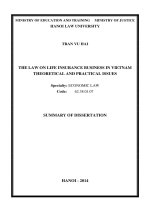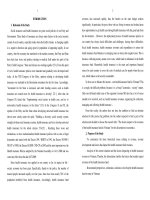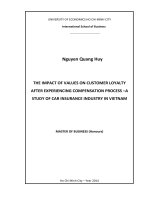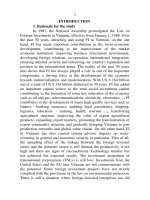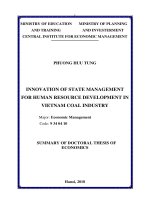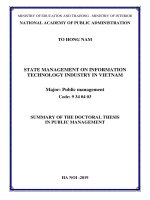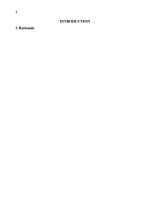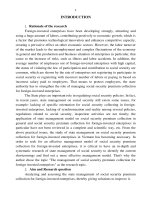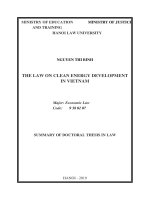Summary of Doctoral thesis: The management of unemployment insurance fund in Vietnam
Bạn đang xem bản rút gọn của tài liệu. Xem và tải ngay bản đầy đủ của tài liệu tại đây (666.52 KB, 30 trang )
1
INTRODUCTION
1. Rationale
2
In Vietnam, workers’ rights as well as unemployment issue are always
paid attention to by the Party and the Government in each period of the socio
economic development process. In the period before 2009, the government
budget spent hundreds of billions of VND each year to support financially for
tens of thousands of workers through severance allowances, jobloss
allowances or allowances regimes for redundant laborers when rearranging
Stateowned enterprises,….In order to better ensure the benefits for workers
when they are unemployed and to reduce the burden on the state budget, at the
9th session of National Assembly, term XI, the Law on Social Insurance was
promulgated and Unemployment Insurance (UI) regulations became effective
from 1stJanuary 2009. After five years of implementation, the Unemployment
Insurance has been more comprehensive in the Employment Law passed by the
National Assembly, term XIII, at its 6th session and took effect on 1st January
2015. After the process of formation and modification up to now, UI has
gradually come to life and is "lifeline" for workers when they lose their jobs.
According to data of Vietnam Social Insurance by 2015, Vietnam has over
10.3 million laborers participating in UI system with the revenue of over 9.7
trillion VND and over 4.5 trillion VND was spent for more than 545,000
beneficiaries. Thus, the UI budget is not only enough to pay the regimes but
also surplus over 49 trillion.
In addition to the achievements, the management of UI system still
reveals many inadequacies in policy such as: employees who contribute to
UI but do not benefit from retirement policy, there is no age limits for being
entitled to unemployment insurance benefits. Therefore, some workers who
retire from work benefit from the UI regime first then apply for retirement
allowances. , maternity beneficiaries actively quit their jobs to enjoy both
maternity and unemployment benefits,…
3
In the implementation organization, the fraud of UI benefits is still
occurring in various forms, affecting the management and preservation of
UI budget and being expressed as: employees actively take leave or
corporate with employers to carry out procedures to enjoy UI benefits,
while the company still can arrange jobs for these employees; unemployed
workers are having unemployment allowance but at the same time still
work and contribute to social insurance (SI) and UI in other localities to
avoid being detected; Some companies have dodged the law for evading to
contribute to UI system by signing labor contracts with employees who
have less than 3 months of employment or insufficiently contribution by
lower the number of employees and salaries, UI outstanding debts, ...
Employment information is limited; vocational training is reasonable in
terms of time, funding and training industry; not meeting the needs of the
labor market. The coordination mechanisms in policy implementation and
inspection between agencies and organizations is not enough strict. On the
other hand, UI is mainly aimed at paying unemployment benefits with
absolute amount of allowances is much greater than that of other regimes,
the allowance for training, retraining and upgrading of vocational skills to
maintain unpaid labor, the policy to limit the situation of job dismissal,
supporting UI contributions rate or enhance the role of the labor market are
not paid enough attention…then lead to great surplus of UI fund.
With the abovementioned issues, "The Management of
Unemployment Insurance Fund in Vietnam" is the topic chosen by the
author to study in order to overcome shortcomings and inadequacies still
remain, thereby contributing to the management of UI fund more
strict ,effective and lawfully.
2. Research Goals
a. Overall Goal:
Evaluating the actual situation of UI fund management and proposing
some key solutions to manage UI fund in Vietnam stricty, effectively and
lawfully.
4
b. Specific Goals:
To systematize, supplement and clarify basic theoretical issues on
UI fund and the management of UI fund;
To analyze and evaluate the status of revenue and expenditure
management, balance of the UI fund, also to clarify the factors affecting the
management of UI fund in Vietnam;
To Propose solutions and recommendations to manage UI funds
closely, effectively and lawfully.
3. Research subjects and scope
a. Thesis’ research subjects is managing UI fund.
b. Thesis research scope
Content: The thesis researches the theoretical issues and the practical
management of the UI fund. In particular, mainly researching on management
of revenue expenditure and the balance of UI fund in Vietnam.
Location: UI fund management in Vietnam.
Period: period from 2011 to 2015
4. Methodology
The thesis uses the methodology of dialectical materialism, historical
materialism to systematize and to clarify basic theoretical issues on UI fund
management.
The dissertation uses the synthesis of statistics research methods such
as: synthesize, analysis, comparative evaluation and lessons learned.
During researching process, the thesis combines both qualitative and
quantitative methods. In order to implement these methods, primary and
secondary data sources are collected from the Vietnam Social Insurance, the
Ministry of Labor, Invalids and Social Affairs and the relevant ministries and
agencies and via field survey sheets.
5. Literature Reviews
5.1. International Research
5
Wandner, S. A., & Stengle, T. (1997). “Unemployment insurance:
Measuring who receives it”;
Schwartz, J. (2009). “Essays on unemployment insurance and the
business cycle”;
Mullins, S. D. (2012). “The Unemployment Impact of the 2008
Extension of Unemployment Insurance”;
Carter, J., Bédard, M., & Bista, C. P. (2013). “Comparative review
of unemployment and employment insurance experiences in Asia and
worldwide”;
Hu, Y. W., Impavido, G., & Li, X. (2009). “Governance and Fund
Management in the Chinese Pension System”.
5.2. Local Research
Sinh, D.V. (2005). “Improving the management of Social Insurance
Fund in Vietnam”.
Quang, N.V. (2009). “Models and experiences of implementing
unemployment insurance in the world "
Dinh, N.V. (2008). " Organizing Unemployment Insurance in
Vietnam";
Trung, L.Q. (2001) and his team. Ministry level Research. "Solutions
to promote nonstate enterprises participating in unemployment insurance up to
2020".
Centre of regional social and environmment development Vietnam
(CERSED). (2013). "Assessing the status of the unemployment insurance fund
and proposing plans to transform the fund model".
Thao, L.T.P. (2014). "The management of unemployment insurance
fund in Hung Yen Social Insurance Branch";
- Giang. P.T (2010). “Completing the collection mechanism of social
insurance contribution in Vietnam";
Chinh, N.T. (2010). "Completing the organizations system and
6
payment activities of social insurance in Vietnam";
Lam. T.Q. (2016). "Factors affecting the revenue of health insurance
fund in Vietnam"
Truong. N.Q. (2016). "Current State management of unemployment
insurance in Vietnam."
5.3. Issues to study further
Summary of domestic and foreign studies, the author found that there
are still many researching gaps related to UI fund management, specifically:
Theoretical gap: The concept of Unemployment Insurance, UI fund and
UI Management, distinguishing UI fund with social insurance fund, the system
of indicators related to UI management, factors affecting the management of
UI fund.
Methodological gap: The majority of research are based on secondary
data sources, while primary data sources through surveys are limited. The
methods used in the study were mainly analysis, comparison, statistics,
description ...
Practical gaps: UI management needs to be analyzed thoroughly, in
detail and objectively in terms of organization across the country.
The management of UI fund in Vietnam is mainly studied in terms of
organization implementation by social insurance agencies. Therefore, the
solutions and recommendations of the thesis are aimed at completing and
improving the efficiency of UI fund management, proposing amendments to
policies and management models in Vietnam.
6. Theorical frame work and Research model
Based on literature reviews and remaining gaps in previous studies, the
author suggests expected study model as follows:
7
Picture 1: Expected study model
7. New contributions of the thesis
Theoretical and academic contributions:
+ The thesis researches and clarifies the concepts of UI, UI fund and UI
fund management;
+ Identifying the factors influencing UI fund management and
explaining the content of each factor;
+ Identification and selection of indicators to serve the management of
UI funds.
New contributions from the thesis:
+ Analyzing and clarifying the current status of UI fund management
in Vietnam (2011 2015).
+ Analyzing the factors influencing the management of UI fund in
Vietnam including policies and laws on UI; social and economic
conditions; participating subjects and beneficiaries; level of contribution,
8
level of benefits; Organizing the management of revenue and expenditure
and balancing the UI fund; propaganda and dissemination of policies and
laws; the work of checking and inspecting UI and the coordination between
functional agencies related to UI system .... Simultaneously, the authors
have investigated both policy beneficiaries and the people who directly
implement UI policies in order to identify three factors affecting the
management of UI fund in a scientific and objective way: legal policies,
socioeconomic conditions, quality of the UI fund management agencies’
human resources.
+ Proposing solutions to complete and improve the effectiveness of UI
fund management, including solutions to UI policies and implementing UI
policies in Vietnam.
8. Content
Apart from the introduction, conclusions, list of references,
appendices ... The thesis is structured into 3 chapters:
Chapter 1: The scientific basis of the Management of Unemployment
Insurance Fund.
Chapter 2: The current status of Unemployment Insurance Fund
Management in Vietnam.
Chapter 3: Viewpoints, orientations and solutions to improve the
management of unemployment insurance fund in Vietnam.
9
CHAPTER 1
THE SCIENTIFIC BASIS OF THE MANAGEMENT OF THE
UNEMPLOYMENT INSURANCE FUND
1.1. Unemployment insurance fund
1.1.1. Overview of Unemployment Insurance
1.1.1.1. The definition of unemployment insurance
By studying previous scientists’ literature and views about
unemployment insurance, the author assumes:
Unemployment insurance is a guarantee to replace or offset a part of
income for a certain period of time for unemployed workers in order to
stabilize their and their families’ lives, to help the unemployed to return to labor
market early and to limit the situation of labor dismissal by supporting
measures of UI, thereby contributing to ensuring social security.
1.1.1.2. The nature of unemployment insurance
1.1.1.3. The role of unemployment insurance
1.1.2. Unemployment insurance fund
1.1.2.1. The definition and source of UI fund
According to ILO recommendations and UI in some countries around the
world, the author assumes:
UI fund is a concentrated monetary fund made up of contributions by
contributors with the main purpose of replacing or offsetting a part of income
for a given period of time for unemployed workers, also supporting to training
and job introduction to the unemployed to help them early return to the labor
market and limit layoffs situation.
1.1.2.2. The characteristics of unemployment insurance fund
Firstly, the government is the only entity regulating the establishment
and the use of UI fund for the purpose of ensuring social security.
Secondly, UI fund is a concentrated monetary and community fund with
10
Thirdly, the release, the existence and the development of UI
always stick to the main purpose of ensuring life for laborers and their
families when they are unemployed.
Fourthly, UI fund is always influenced by a number of factors, in
which the development of social economy is always important and has a
synergy effect.
1.2. The management of unemployment insurance fund
1.2.1. The definition of unemployment insurance fund management
Under the author’s perspective, UI fund management is considered as
the impact of management actors on the management, planning and
organization of the fund to achieve expected objectives according to the
principles and management methods of each country in each period.
1.2.2. Unemployment insurance fund’s managerial Target
UI fund must be not only strictly managed from the inputs, including
identification of participants, full and timely charges; strictly controlling the
payment of allowances to the right beneficiaries, but also to periodically
balancing UI income – expenses, forecasting and making appropriate
adjustments in medium term and long term in order to manage and utilize UI
fund effectively with the highest objective to ensure that employees receive full
benefits before and after unemployment and reintegrate into the labor market,
and contribute to ensuring national social security.
1.2.3. The principles of unemployment insurance fund management
Firstly: Contribution – Benefits
Secondly: The law of large number
Thirdly: Balacing income – expenses
Fourthly: Fair, open, transparent
Fifthly: Managing the fund centrally, safely and effectively
1.2.4. Contents of UI management
1.2.4.1. Managing the collection of UI
11
1.2.4.2. Managing UI payment for beneficiaries
1.2.4.3. Inspection and supervision
1.2.4.4. Managing the balance of UI fund
1.2.4.5. Managing investment activities of UI funds
1.3. Key factors affecting the management of UI funds
1.3.1. Legal policies
1.3.2. Social and economic conditions
1.3.3. The propaganda and the dissemination of unemployment insurance
policies
1.3.4. Inspection and supervision
1.3.5. Organizing the implementation of legal policy on unemployment
insurance fund management
1.3.6. The quality of unemployment insurance fund management agencies’
human resources
1.3.7. IT applic ations
1.4. Unemployment insurance management in some countries and
lessons learned for Vietnam
1.4.1. Unemployment insurance management in some countries
1.4.1.1. In Germany
1.4.1.2. InJapan
1.4.1.3. In Korea
1.4.1.4. In China
1.4.2. Lessons learned for Viet Nam
Firstly, it is necessary to closely manage the income of UI by identifying
the right participants to UI system, collecting contribution in full and in time.
Secondly, it is necessary to closely manage UI payment process by
12
identifying the right beneficiaries, level and exact time of payment, paying in
full and in time.
Thirdly, balancing income expenses of UI fund annually, controlling the
unplanned increase and decrease of UI fund forecasting changes in the medium
and long term.
Fourthly, UI management should pay special attention to research,
modification and supplementation of UI policies in line with the actual
situation and in accordance with the 4.0 revolution.
Fifthly, in addition to unifying and concretizing legal policies on UI,
Vietnam government should pay attention to the strictness of policies and laws
promulgated through regular inspection and supervision of policy
implementation as well as compliance with the legal policies of contributors
and beneficiaries.
Sixthly, increasing the application of information technology in
management, developing a united and focused implementation process in order
to strictly control the participants and beneficiaries of UI policies.
13
CHAPTER 2
THE CURRENT STATUS OF UNEMPLOYMENT INSURANCE FUND
MANAGEMENT IN VIETNAM.
2.1. Unemployment Insurance Fund in Vietnam
2.1.1. Formation process and purpose of using unemployment insurance
fund in Vietnam
2.1.2. Unemployment Insurance Management Agency and
Unemployment Insurance Fund in Vietnam
2.1.2.1. Government management of unemployment insurance
According to Decree No.14/2017/NDCP dated 17/2/2017 regulating the
functions, tasks, powers and organizational structure of the Ministry of Labor, War
Invalids and Social Affairs (MOLISA), MOLISA is an governmental agency which
performs governmental management function of different fields including
employment, vocational training, labor, salary, wage, social insurance (compulsory
social insurance, voluntary social insurance, unemployment insurance),… in
Vietnam.
2.1.2.2. Career management of unemployment insurance and
unemployment insurance fund
14
According to Article 59 of Employment Law: unemployment insurance fund is
independent. Social insurance organizations shall control the collection, spending,
management and the use of unemployment insurance fund. Investment activities
from Unemployment Insurance Fund must be safe, transparent, effective and
recoverable when it is necessary. The Government specify the rate of state budget
support, the management and use of the Fund, the implementation of
unemployment insurance.
On 05th January 05 2016, the Government issued Decree No.01/2016/NDCP
defining the functions, tasks and powers of Social Insurance Organization.
Accordingly, Vietnam Social Insurance is a governmental agency under the
Government, having the function of organizing the implementation of social
insurance and health insurance regimes and policies; organizing the collection and
spending of UI regime; managing and using funds: social insurance, unemployment
insurance, health insurance.
15
Picture 2.1. Organizational chart of social insurance in Vietnam
2.2. The current status of unemployment insurance management in
Vietnam
2.2.1. Managing the collection of unemployment insurance
2.2.1.1. Developing plan for the collection of unemployment insurance
2.2.1.2. Managing unemployment insurance participants
2.2.1.3. Managing unemployment insurance contribution rate and contribution
methods
2.2.1.4. Organizing the evaluation of implementation results of unemployment
16
insurance collection plan
2.2.2. Managing the spending of unemployment insurance fund
2.2.2.1. Estimating the expected expenditure of UI regime
2.2.2.2. Managing unemployment insurance beneficiaries
2.2.2.3. Managing the amount of unemployment insurance benefits
2.2.2.4. Organizing the evaluation of implementation results of unemployment
insurance spending
2.2.3. Inspection and supervision
2.2.4. Managing the balance of income expenses of UI fund
Table 2.7: The balance of income expenses of UI fund
(2011 2015)
Unit: billion VND
Years
2011
2012
2013
2014
2015
Opening
balance
8.994
15.587
23.236
31.870
41.454
Increase in
fund
7.843
10.460
12.734
14.612
12.864
Decrease in
fund
1.250
2.811
4.100
5.028
5.137
Closing
balance
15.587
23.236
31.870
41.454
49.181
Source: Vietnam Social Insurance
17
Overall, it can be seen that UI fund is mainly used to pay unemployment
benefits to unemployed people with huge amounts of money comparing to
vocational training or health insurance contributions for the unemployed. Although
the policy of supporting the cost of training, retraining and upgrading of vocational
skills to maintain employment for workers is established in Vietnam labor law,
enterprises’ access to this policy is still difficult so there are no specific data on the
payment of this regime.
In fact, UI policies in Vietnam are passive, mainly used to pay unemployment
allowance but not other proactive labor market policies as some countries in the
world. Typically, vocational training, employment introduction and information on
labor market, policies to support enterprises before the dismissal of labor has not
met the actual needs, ... This is also one of the main causes for Vietnam
unemployment insurance fund’s huge surplus over the years.
2.2.5. Managing investment activities of UI fund
2.3. Nam Assessing the management of unemployment insurance
fund in Vietnam
2.3.1. Achievements
a. UI policies and laws
b. Propaganda and dissemination of UI policies and laws
c. Inspection and supervision:
d. Organizing the implementation of unemployment insurance management
policy
e.The quality of of social insurance agencies’ human resources
2.3.2. Limitations
a. UI policies and laws:
Table 2.13: The evaluation of VSS officers on employers’ compliance
with UI policies and laws
18
Number of
participants
Rate
Very bad
%
% valid
159
39.4
39.4
Bad
12
3.0
3.0
Good
208
51.5
51.5
25
6.2
6.2
404
100.0
100.0
Very good
Total
Source: Author’s survey .
b. Propaganda and dissemination of UI policies and laws:
c. Inspection and supervision:
d. Organizing the implementation of unemployment insurance management
policy:
Figure 2.11. Employees’ evaluation on the quality of vocational training
and satisfaction in job counseling and referral
e. IT applications:
2.3.3. Evaluating the factors affecting the management of unemployment
insurance fund
2.3.3.1. Evaluating the level of participants’ influence to UI fund management
a. Models and research hypotheses
19
The author suggests the following research hypotheses:
Research
Previous research’s
Hypothesi
Descriptions
authors
s
Female participant rate is lower Lam (2016); Diamond &
H1
than male participant rate
Mirrlees (1978).
Scheve & Stasavage
Employee’s age is strongly
positively correlated with the level (2006), Gao, Yang & Li
(2012).
H2
of possibility of participating
unemployment insurance.
H3
H4
H5
H6
The level of worker’s education is
positively correlated with the level
of possibility of participating
unemployment insurance
Employees in both Stateowned
and FDI sectors have a higher level
of participating unemployment
insurance than other enterprises.
Urban workers have higher levels of
participating unemployment
insurance than in rural areas.
The more opportunities employees
have to participate in unemployment
insurance, the higher the level of
possibility of participating
unemployment insurance.
Atkinson (1987);
Oyekale (2012);
Carrin (2007), Liu &
Hsiao (1995); Ahmad
(1991).
Chiappori (2000);
Cardon & Hendel
(2001).
Cardon & Hendel
(2001); Diamond &
Mirrlees (1978).
20
Research
Hypothesi
s
Descriptions
H7
The level of accessing to
information about unemployment
insurance is positively correlated
with the level of unemployment
insurance participation
Previous research’s
authors
Cardon & Hendel
(2001); Chiappori
(2000); Chiappori &
Salanié (2013).
b. Results of data analysis
Table 2.16: The Hosmer Lemeshow goodness of fit test for logistic
regression
The pvalue obtained is greater than 5% so we do not have statistical
evidence to reject H0. In other words, the logistic regression model
developed to assess the level of UI participation of employees is consistent
with the sample data of the study. Based on the results of the analysis for
model 1, the proposed research hypotheses will be verified (or rejected) as
follows:
Hypothesis H1. Because the regression coefficient for female sex is
negative, hypothesis 1 is confirmed.
Hypothesis H2. The regression coefficient of age is positive so the
regression coefficient of age is consistent with the hypothesis H2.
Hypothesis H3. The higher the level of education , the better
understanding of the legal policy , the orientation and the choice of work
are in line with reality and needs.
Hypothesis H4. Based on the sign of regression coefficients, it can be
21
assumed that the level of UI participation of employees in these two groups
of enterprises is higher.
Hypothesis H5. The regression coefficient for the urban labor group is
positive at 0.312 and is statistically significant at 5% (PValue = 0.045 <
5%) so the analysis results show that this hypothesis is confirmed and in
accordance with Bohn’s research results (2001).
Hypothesis H6. Because the sign of regression coefficient is positive
0.043, it can be seen that the level of easy access and available information
on UI has a positive influence on the level of possibility of employee’ UI
participation.
Hypothesis H7. This hypothesis suggests that the ease with which an
unemployment insurance fund can be accessed without any administrative
and time hindrance has a positive impact on the level of UI participation.
2.3.3.2. Evaluating the impact of factors on the management of
unemployment insurance fund
a. Models and research hypotheses
In order to verify and assess the impact of factors affecting the
implementation of UI fund management, the author proposed the Logistic
model as follows:
The implementation of UI fund management = (Quality of
human resources, policies, laws, socio-economic conditions)
The second research model will be implemented in two steps. In the
first step, the author analyzes EFA factor to derive factor variables that
represent the independent variables of the model: Human Resource Quality,
Legal Policy, Socioeconomic Conditions (Field, 2009) and the result will
be a continuous variable.
Research
Hypothesi
s
Descriptions
Previous research’s
authors
22
H1
The quality of human resources of
social insurance agencies has a
positive impact on the
implementation of UI fund
management
Diamond (1996);
Normand & Busse
(2002); Rupp &
Stapleton (1995).
H2
UI policies and laws have a positive
impact on the implementation of UI
fund management
Normand & Busse
(2002); Rupp &
Stapleton (1995).
H3
Socioeconomic conditions affect
the implementation of UI fund
management.
Ahmad (1991);
Normand & Busse
(2002); Sinn (1996).
b. Results of data analysis
Table 2.17: Results of logistic regression analysis
Coefficients
Estimat
e
Std.
Error
z value
Pr( > |z|)
(Intercept)
4.324
0.657
3.463
0.071***
The quality of human
resources
0.085
0.376
1.568
0.009*
UI policies and laws
0.460
0.006
0.272
0.046**
Socioeconomic conditions
0.277
0.311
0.982
0.249
The quality of human resources. This factor is statistically significant at
1%. According to the results shown in Table 2.15, human resource quality
influences positively on UI management. These results are consistent with the H1
hypothesis and are relevant to reality as UI officials’ managerial tasks includes
planning, implementing, and monitoring the process of collecting and spending UI
fund.
UI policies and laws. This factor is statistically significant at 5%. The
analysis results in Table 2.15 show that UI policies and laws influence
positively on UI fund management. This result also confirms the H2
hypothesis.
23
Socioeconomic conditions. According to the results obtained in Table
2.15, it can be seen that the socioeconomic conditions have a positive
influence on UI und management.
Between above three factors, the legal policy is the main factor affecting
the implementation of UI management. According to author's survey of all
three groups about the impact of the legal and policy factors on UI
management, the results are highly influential and very influential.
Figure 2.17: The evaluation of VSS staff on the impact of legal and policy
factors on UI fund management.
Figure 2.18. The assessment of employers and employees on the impact of
policy and legal factors on UI fund management.
CHAPTER 3
VIEWPOINTS, ORIENTATIONS AND SOLUTIONS TO IMPROVE
THE MANAGEMENT OF UNEMPLOYMENT INSURANCE FUND
24
IN VIETNAM.
3.1. Orientations and viewpoints of organizing the management of
unemployment insurance fund
3.1.1. Orientating managerial targets of unemployment insurance fund
To study and amend Social Law in the orientation of expanding social
insurance participants. To complete the policies and laws and management and
using mechanisms of social insurance fund, to ensure the fund's balance and
growth requirements. Reviewing and supplementing the regulations forcing
employers to properly and fully fulfill the obligation to pay social insurance
contributions for laborers. Modifying unemployment insurance policy to ensure
the legitimate interests of unemployed workers and avoiding insurance fraud.
To consolidate social insurance apparatus at all levels in order to
implement social insurance and health insurance regimes and policies to meet
increasing requirements. Promoting the reform of administrative procedures,
improving service quality, reducing inconvenience for participants in social
insurance and health insurance.
To complete the information technology infrastructure (computer networks,
servers, workstations, network security, data center and software systems,
databases, online public services on the Internet) in order to solve/implement
policies, social insurance, health insurance. Connecting and communicating
information between units in the entire social insurance industry throughout the
country and units which are also responsible for implementing unemployment
insurance regimes and policies in the labor industry.
As a result, the Party and the government have clearly defined their future
goals with important contents of researching and revising legal system, training
and improving the quality of human resources and specially focusing on
promoting the application and development of information technology to meet
the requirements of sustainable development and international integration.
These are also important factors mentioned in the thesis’ rationale part and
being confirmed, proved in the analysis and assessment of the current status of
UI fund management in Vietnam, that is: UI policies and laws, the quality of
25
unemployment fund management agencies’ human resources and the
application of information technology.
In pursuing the abovementioned orientations and objectives, social
insurance agencies which have the managerial function of UI must ensure
the financial principles closely and effectively manage UI funds. The
income of the UI is always controlled strictly, timely with the right objects.
UI fund must be used effectively, not only to pay UI benefits to the
unemployed but also to respond to proactive policies to assist workers in
limiting unemployment situation by various measures on the basis of
balancing the income – expenses of UI funds in medium and long term. To
publicize the process of paying UI contributions and the salary level used as
the basis for employees’ contribution amount in order to control the
situation of employers’ declaration or payment of UI contributions as well
as UI collection in accordance with employees’ salary.
3.1.2. Viewpoints on unemployment insurance fund management
3.1.2.1. General view on unemployment insurance
Unemployment insurance policies must be tools that manage, control
and operate effectively labor market by developing and transforming into
employment insurance policies for the purpose of maintaining employment for
the workers, then there are measures to support job creation for the
unemployed. Incorporating closely unemployment insurance policies with
employment policies, labor market information, social insurance.
Expanding the number of UI participants must be linked to improve
management capacity. When UI policies change, the number of participants
are increasing, the management of participants must be strict to ensure
collecting from right subjects, sufficient contributions and not let the
employers and employees can find ways to evade paying contribution or to
pay insufficiently in accordance with regulations.
Always paying attention to the propaganda and dissemination of UI
policies. The task of propagandizing and disseminating policies must be
considered as a key task and a regular, longterm task. The propaganda
